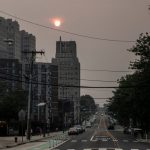Spring has sprung in America’s capital, bringing with it a resplendent bloom of white and pink cherry blossoms that is one of the city’s grandest annual traditions.
But this year, as Washington DC’s residents embrace a relative return to normal after a tumultuous year marked by the coronavirus and civil unrest, the earlier-than-anticipated bloom may point to yet another looming crisis: climate change.
Unusually warm weather in Washington accelerated the bloom cycle of the National Mall’s 3,800 cherry trees, causing the blossoms to pop days ahead of schedule in what experts say is a new normal that will make their arrival increasingly difficult to predict.
“Empirical data shows the peak bloom date for the cherry trees is occurring earlier than it did in the past,” said Mike Litterst, a spokesman for the National Park Service.
Washington’s cherry trees now reach peak bloom about six days sooner than they did 100 years ago. At the same time, weather station measurements in the US capital show the temperature has increased by 1.6C (2.88F).
“Since heat breaks dormancy in flowering trees, earlier cherry blooming is consistent with heating caused by climate change, although research has not yet examined all of the potential factors that could have caused the earlier blooming,” Litterst said.
The trees at the Tidal Basin reached their flowery peak on 28 March, according to the park service, which defines “peak bloom” as the day when 70% of the Yoshino cherry blossoms open. On 4 March, the park service predicted peak bloom would fall between 2 April and 5 April.
“The Yoshino cherry trees have reached peak bloom after temperatures well above average for much of the last week sped us through the final stages of the blossom cycle,” the agency wrote on Instagram. It added that the warm weather propelled the cherry blossom buds through the final stages of their six-stage cycle, advancing them from peduncle elongation – stage 4 – to peak bloom in just four days.
“The four days from peduncle elongation to peak is the fastest the trees have moved through the last two stages in the last 30 years (matched in 2015),” the agency wrote.
Peak bloom often occurs between the last week of March and the first week of April, but exceptionally warm or cool temperatures can shift the timeline. This year, peak bloom was reached four days ahead of the 30-year-average date of 1 April.
In 2020, peak bloom arrived on 20 March, the earliest since 2012 when it also occurred on that day. The blooms are tied for the third earliest on record. In 2018, peak bloom did not arrive until 5 April following wicked windstorms and a late-season snow.
Washington’s bloom came just two days after the cherry blossoms in Kyoto reached peak bloom on 26 March, the earliest in nearly 70-years of formal record keeping – and possibly ever.
“We can say it’s most likely because of the impact of the global warming,” Shunji Anbe, an official at the observations division at the Japan Meteorological Agency, told the Associated Press.
The annual spectacle in Washington typically draws as many as 1.5 million visitors to the Tidal Basin, but the coronavirus pandemic has dramatically reduced crowd sizes for a second year in a row. Local officials are urging visitors to wear a mask and practice social distancing.
To discourage crowds, the park service limited access to the Tidal Basin during the bloom and urged residents to avoid the area altogether and enjoy the blooms remotely. The Trust for the National Mall is hosting a live stream of the cherry blossoms.

Average Rating